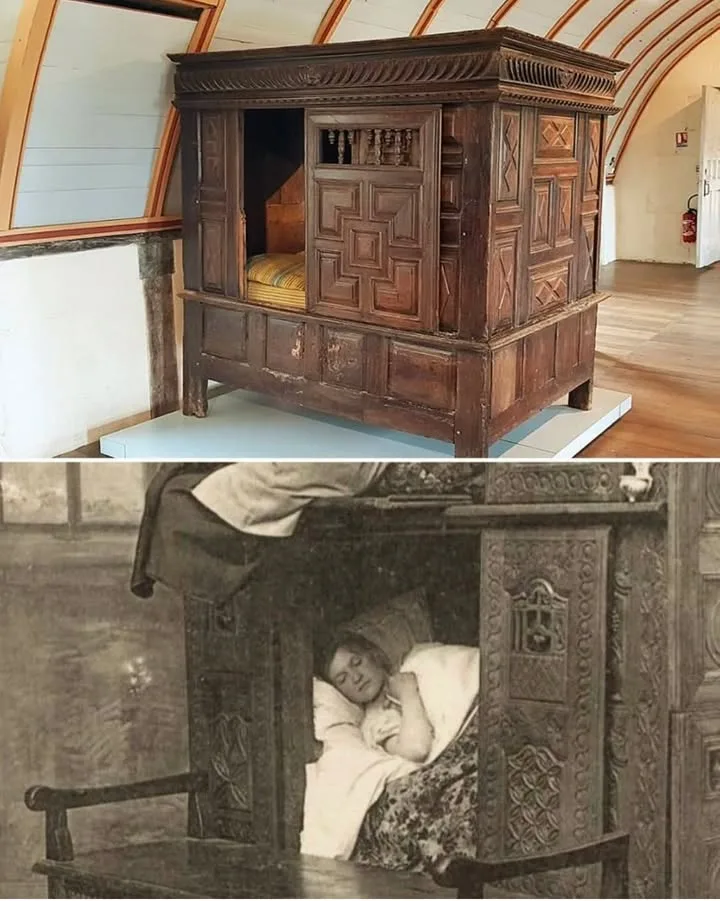Here in Phnom Penh, with our modern homes and air conditioning, we might take a comfortable night’s sleep for granted. But cast your mind back some 600 years, to a world vastly different from our own. Imagine homes with roaring fireplaces that barely warmed the corners, and living spaces often shared by entire families, servants, and even livestock. In such an environment, the simple act of sleeping comfortably was a significant challenge – one brilliantly solved by an ingenious piece of furniture: the box bed.
The image before us tells a compelling story, presenting two views of this remarkable historical design:

In the top panel, we see a beautifully preserved example of a medieval box bed, likely displayed in a museum setting. Crafted from rich, dark wood, its robust construction and intricate carvings speak to the skill of the artisans who made it. It’s essentially a large, self-contained wooden box, with a small opening on one side, allowing a person to climb inside. The top, sides, and often a door, fully enclose the sleeping space.
The bottom panel offers an even more evocative glimpse into its use: a vintage photograph (likely from a later period, but perfectly illustrating the concept) shows a person nestled snugly within such a bed, clearly asleep and utterly encapsulated by its wooden walls. This image immediately conveys the profound sense of coziness and privacy this design offered.
So, what made these enclosed beds, popular during the Medieval period (roughly 5th to 15th centuries), so highly valued? It came down to two primary needs:
- Unparalleled Warmth and Comfort: Medieval homes, particularly outside of noble estates, were notoriously drafty and difficult to heat effectively. Open fireplaces provided some warmth, but heat quickly dissipated. The genius of the box bed lay in its enclosed structure. Once a person was inside, their body heat was trapped within the small space, creating a remarkably warm and insulated sleeping environment. Imagine climbing into this wooden cocoon on a chilly night – a truly inviting retreat from the cold outside.
- A Sanctuary of Privacy: In an era where private bedrooms were a luxury largely reserved for the very wealthy, most people slept in communal living areas. Privacy was a concept often unknown. The box bed provided a vital, intimate sanctuary. With doors that could be closed, it offered a much-needed sense of personal space, allowing individuals to rest, read, or simply have moments to themselves, shielded from the hustle and bustle of a busy household. It transformed a communal room into a series of individual, private cells for slumber.
Beyond warmth and privacy, these beds also offered a degree of protection. They could shield sleepers from drafts, falling debris, and perhaps even small vermin or insects that might roam a less-than-sanitary medieval home. The solid construction also lent a feeling of security.
The ornate craftsmanship seen in the example suggests that while the concept was practical for many, such a well-made, decorative piece might have belonged to a household of some means. Simpler versions undoubtedly existed for the less affluent.
Over time, as architectural styles evolved, heating methods improved (think fireplaces becoming more efficient, then later, central heating), and the concept of separate bedrooms became more commonplace, the necessity of the box bed diminished. Yet, their legacy remains as a testament to human ingenuity in adapting to environmental challenges and societal norms.
Looking at these images today, from our modern context, the box bed stands as a fascinating reminder of how historical furniture was not just about aesthetics, but about practical solutions to very real daily needs. It’s a wonderful piece of design history that truly embodies warmth, comfort, and the enduring human desire for a quiet, private space to rest.





